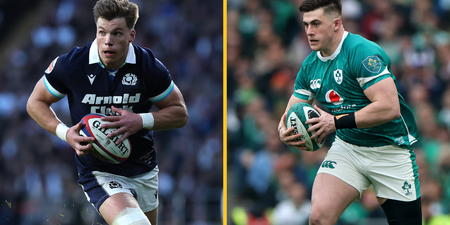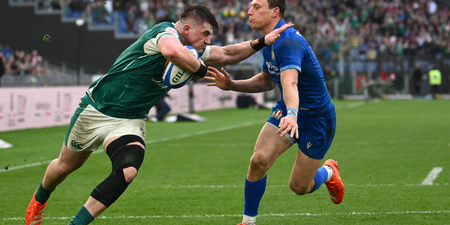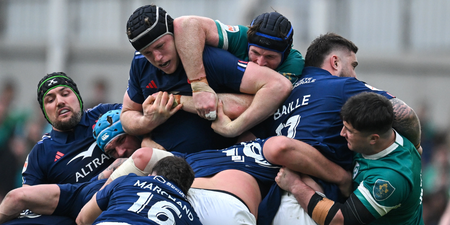“I think I have to take him for a box-kicking lesson during the week after his kick to touch. Other than that, he was brilliant.”
Conor Murray was not lying.
Brian O’Driscoll had filled is as emergency scrum-half for the final 10 minutes of a fraught survival job at the Millennium Stadium. February 2013 and Ireland had thundered into a commanding, 30-3 lead only to see Wales roar back with 19 unanswered points.
In preventing a Toby Faletau score, on 69 minutes, Murray had taken a man out illegally and was yellow-carded. O’Driscoll stepped in and, at one stage, box-kicked away possession for a minimal gain.
We thought Murray was joking only to learn that he had collared O’Driscoll in training, the next week, to offer pointers.
Just 23 years old and giving the great man tips.
It was nothing new for Murray, a star in the making from an outrageously early age.
He made a name for himself as a canny operator with Garryowen and was drafted into the Ireland U20 squad in 2009. Still, he was far from the star name. Peter O’Mahony and Rhys Ruddock were the shining lights.
Murray was second-pecking to Lansdowne No.9 Matt Healy, who tore it up on the wings for Connacht and is in South Africa for the upcoming three-Test series.
Ian Costello, his former coach at Munster, was in charge of the province’s academy when Murray arrived. The O’Mahonys [Peter and Ronan] were highly rated but Murray was almost a complete package. He just needed the confidence that came with game time. Costello says:
“Conor Murray was a little more understated with the presence he had back then… [but] when you looked at Conor, he just had exceptional fundamentals. His kicking is world-class as well. They were in place from an early age. They were so good, so you knew he could accelerate (his advancement). Sometimes, they just need the opportunity.”
Murray got that opportunity in April 2010 with his senior Munster debut. Within a year, he was the province’s starting No.9 and had relegated Tomás O’Leary and Peter Stringer to support roles. By October 2011 he was lining out in a World Cup quarter-final against Wales.
It took until June 2012, and a coming-of-age game against New Zealand in Christchurch, for Murray to first broach the world-class bracket. He has never looked back.
Still, he works harder and harder behind the scenes.
In 2013, while on the Lions tour to Australia, coach Gareth Jenkins noticed Murray sticking around after training to practice his goal-kicking with the likes of Johnny Sexton and Leigh Halfpenny. It was something he has always done for Munster.

Jenkins, who kicked the Lions to a series victory against South Africa in 1997, was so impressed by Murray’s technique that he advised him to seriously consider it as an option in matches. The following season saw him lap over two conversions in a Guinness PRO12 win over Edinburgh.
He has teased Ian Keatley ever since about his 100% record off the tee.
As for his passing, Costello remains in awe. “It’s hard to think that people were questioning anything about Conor’s pass as it is the fastest pass and one of the best worldwide,” he declares.
“The power he gets off his wrist… you see him doing things in training with one hand that a lot of guys can’t do with two.”
Getting that power and off a stable base ain’t easy but it is a hell of a lot simpler when you go through rigorous gym exercise like this:
The box-kick
Right now, and since his Test debut, Murray has been synonymous with his box-kick.
He often leaned on that crutch too much in his early years in the green jersey but it has evolved into a fine art. Ireland see Murray’s aerial kicking as an attacking weapon; a way to retain possession and gobble up territory.
There is far more to Murray launching steepling Hail Marys, however.
Isaac Boss, who has trained alongside Murray in the Irish squad for the past five years, tells us:
“That’s a key component of a half-back’s game these days and it is very much an attacking weapon… Conor gets a lot of great height and great length on it, which is probably key when compared to a lot of nines.”
The perfect box-kick, in Murray’s mind, is 25 metres. Sending the ball that far and giving team-mates ample time to chase it down, and contest, is something Murray has perfected.
His drill for this is precise. Murray starts and takes the ball back from the 22 and, stepping back to set himself, sends the ball airborne. The target is the crossbar.
According to Keith Earls, Murray is never satisfied until he pings that crossbar twice in a row.
“He’s often the first guy out for training and last guy to set off,” says Earls. “He’s always improving.”
A leader emerges
Ahead of the Six Nations opener, and with Ireland reeling from injuries, Joe Schmidt was asked if new leaders were emerging within the wider squad.
Rory Best and Jamie Heaslip were mentioned before Schmidt said, “Then there’s Conor, who is a quiet leader for us. His experience has accumulated now to where he feels confident speaking in the group.”
“It’s something that comes with time in the squad,” Murray tells us.
“There are new faces like Ultan Dillane, Josh van der Flier – lads who have played well for their provinces coming in to the setup.
“They just come up to you quietly and ask a few questions about things they want shored up on.
“You’re one of the older or more experienced heads in the team now and, I don’t think about it much, it’s just the way I play. And off the pitch, helping lads out, is just a natural thing. Perfectly comfortable in it and enjoying it.”
Just a natural thing.
With Murray, it always is, always has been.
With Johnny Sexton out injured and Paddy Jackson plunged in among ravenous Springboks, we will need him more than ever.
*Updated from article first posted on February 7
















































